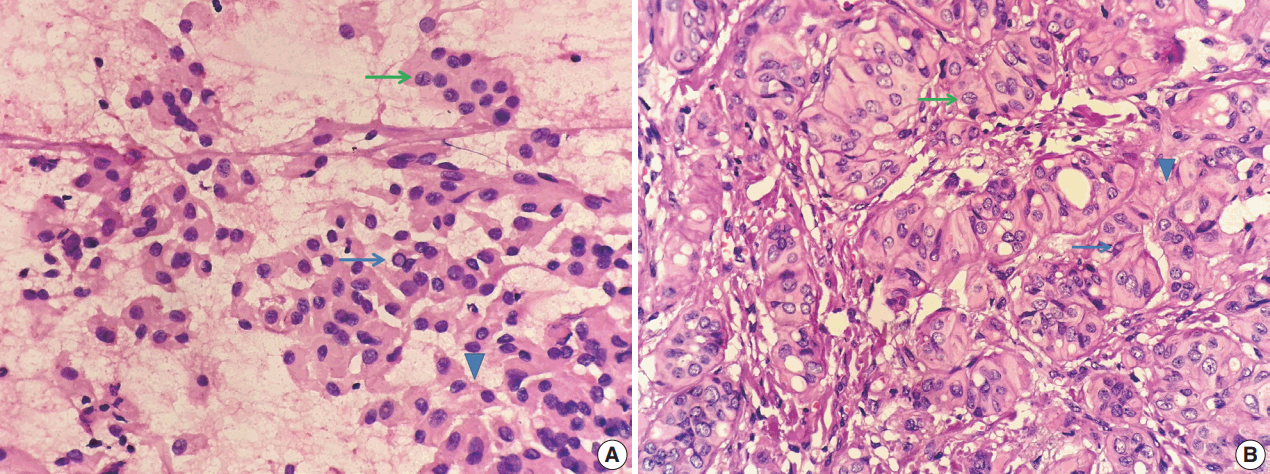Articles
- Page Path
- HOME > J Pathol Transl Med > Volume 51(6); 2017 > Article
-
Review
History and Practice of Thyroid Fine-Needle Aspiration in China, Based on Retrospective Study of the Practice in Shandong University Qilu Hospital - Zhiyan Liu,1,2, Dongge Liu3,4, Bowen Ma5, Xiaofang Zhang1,2, Peng Su1, Li Chen6, Qingdong Zeng7
-
Journal of Pathology and Translational Medicine 2017;51(6):528-532.
DOI: https://doi.org/10.4132/jptm.2017.09.12
Published online: October 19, 2017
1Department of Pathology, School of Basic Medical Science, Shandong University, Jinan, China
2Department of Pathology, Shandong University Qilu Hospital, Jinan, China
3Department of Pathology, Beijing Hospital, Beijing, China
4Chinese Cytology Association, Beijing, China
5Department of Cytopathology, Cancer Hospital of Xinjiang Medical University, Wulumuqi, China
6Department of Endocrinology, Shandong University Qilu Hospital, Jinan, China
7Department of General Surgery, Shandong University Qilu Hospital, Jinan, China
- Corresponding Author Zhiyan Liu, MD, PhD Department of Pathology, School of Basic Medical Science, Shandong University, Jinan, Shandong, China Tel: +86-18560081167 Fax: +86-53182679225 E-mail: zhiyanliu@sdu.edu.cn
© 2017 The Korean Society of Pathologists/The Korean Society for Cytopathology
This is an Open Access article distributed under the terms of the Creative Commons Attribution Non-Commercial License (http://creativecommons.org/licenses/by-nc/4.0) which permits unrestricted non-commercial use, distribution, and reproduction in any medium, provided the original work is properly cited.
Figure & Data
References
Citations

- High Rates of Unnecessary Surgery for Indeterminate Thyroid Nodules in the Absence of Molecular Test and the Cost-Effectiveness of Utilizing Molecular Test in an Asian Population: A Decision Analysis
Man Him Matrix Fung, Ching Tang, Gin Wai Kwok, Tin Ho Chan, Yan Luk, David Tak Wai Lui, Carlos King Ho Wong, Brian Hung Hin Lang
Thyroid®.2025; 35(2): 166. CrossRef - Construction of a Multimodal Machine Learning Model for Papillary Thyroid Carcinoma Based on Pathomics and Ultrasound Radiomics Dataset
Yu-Yan Pang, Zhong-Qing Tang, Chang Song, Ning Qu, Jing-Yu Chen, Dan-Dan Xiong, Zhen-Bo Feng, Gang Chen
Data in Brief.2025; 60: 111583. CrossRef - Deep learning to predict cervical lymph node metastasis from intraoperative frozen section of tumour in papillary thyroid carcinoma: a multicentre diagnostic study
Yihao Liu, Fenghua Lai, Bo Lin, Yunquan Gu, Lili Chen, Gang Chen, Han Xiao, Shuli Luo, Yuyan Pang, Dandan Xiong, Bin Li, Sui Peng, Weiming Lv, Erik K. Alexander, Haipeng Xiao
eClinicalMedicine.2023; 60: 102007. CrossRef - Comparative Study of C-TIRADS, ACR-TIRADS, and EU-TIRADS for Diagnosis and Management of Thyroid Nodules
Zhe Jin, Shufang Pei, Hui Shen, Lizhu Ouyang, Lu Zhang, Xiaokai Mo, Qiuying Chen, Jingjing You, Shuixing Zhang, Bin Zhang
Academic Radiology.2023; 30(10): 2181. CrossRef - The Asian Thyroid Working Group, from 2017 to 2023
Kennichi Kakudo, Chan Kwon Jung, Zhiyan Liu, Mitsuyoshi Hirokawa, Andrey Bychkov, Huy Gia Vuong, Somboon Keelawat, Radhika Srinivasan, Jen-Fan Hang, Chiung-Ru Lai
Journal of Pathology and Translational Medicine.2023; 57(6): 289. CrossRef - Malignancy rates in thyroid nodules: a long-term cohort study of 17,592 patients
M Grussendorf, I Ruschenburg, G Brabant
European Thyroid Journal.2022;[Epub] CrossRef - Prevalence of Thyroid Nodules and Thyroid Cancer in Individuals with a First-Degree Family History of Non-Medullary Thyroid Cancer: A Cross-Sectional Study Based on Sonographic Screening
Giorgio Grani, Livia Lamartina, Teresa Montesano, Laura Giacomelli, Marco Biffoni, Fabiana Trulli, Sebastiano Filetti, Cosimo Durante
Thyroid.2022; 32(11): 1392. CrossRef - A multicenter, prospective study to observe the initial management of patients with differentiated thyroid cancer in China (DTCC study)
Jie Ming, Jing-Qiang Zhu, Hao Zhang, Hui Sun, Jun Wang, Ruo-Chuan Cheng, Lei Xie, Xing-Rui Li, Wen Tian, Tao Huang
BMC Endocrine Disorders.2021;[Epub] CrossRef - Differences in surgical resection rate and risk of malignancy in thyroid cytopathology practice between Western and Asian countries: A systematic review and meta‐analysis
Huy Gia Vuong, Hanh Thi Tuyet Ngo, Andrey Bychkov, Chan Kwon Jung, Trang Huyen Vu, Kim Bach Lu, Kennichi Kakudo, Tetsuo Kondo
Cancer Cytopathology.2020; 128(4): 238. CrossRef - Thyroid FNA cytology in Asian practice—Active surveillance for indeterminate thyroid nodules reduces overtreatment of thyroid carcinomas
K. Kakudo, M. Higuchi, M. Hirokawa, S. Satoh, C. K. Jung, A. Bychkov
Cytopathology.2017; 28(6): 455. CrossRef - The Use of Fine-Needle Aspiration (FNA) Cytology in Patients with Thyroid Nodules in Asia: A Brief Overview of Studies from the Working Group of Asian Thyroid FNA Cytology
Chan Kwon Jung, SoonWon Hong, Andrey Bychkov, Kennichi Kakudo
Journal of Pathology and Translational Medicine.2017; 51(6): 571. CrossRef
 PubReader
PubReader ePub Link
ePub Link-
 Cite this Article
Cite this Article
- Cite this Article
-
- Close
- Download Citation
- Close
- Figure

Fig. 1.
| Bethesda category | Nodule |
|---|---|
| Nondiagnostic | 101 (3.6) |
| Benign | 1,268 |
| AUS/FLUS | 195 (6.9) |
| FN/SFN | 5 (0.2) |
| Suspicious for malignancy | 401 (14.1) |
| Malignancy | 868 (30.6) |
| Total | 2,838 (100) |
| Bethesda category | Nondiagnostic | Benign | AUS/FLUS | FN/SFN | Suspicious for malignancy | Malignancy | Total |
|---|---|---|---|---|---|---|---|
| Cases for surgery | 6 | 90 | 21 | 3 | 200 | 471 | 791 |
| Malignancy on surgery | 0 | 31 | 15 | 2 | 168 | 457 | 673 |
| ROM (%) | 0 | 34.4 | 71.4 | 66.7 | 69 | 97.0 | 85.1 |
| ROM from Zhang et al. [14] (%) |
27.9 | 7.9 | 45.5 | 75.5 | 98.5 | 100 | 65.5 |
| ROM from Haugen [13] (%) |
20 | 2.5 | 14 | 25 | 70 | 99 | Not available |
Values are presented as number (%). FNA, fine-needle aspiration; AUS/FLUS, atypia of undetermined significance or follicular lesion of undetermined significance; FN/SFN, follicular neoplasm or suspicious for a follicular neoplasm. 151 cyst fluid only.
FNA, fine-needle aspiration; AUS/FLUS, atypia of undetermined significance or follicular lesion of undetermined significance; FN/SFN, follicular neoplasm or suspicious for a follicular neoplasm. Risk of malignancy (ROM) in another two thyroid FNA practices in China; ROM in practice in United States.

 E-submission
E-submission




